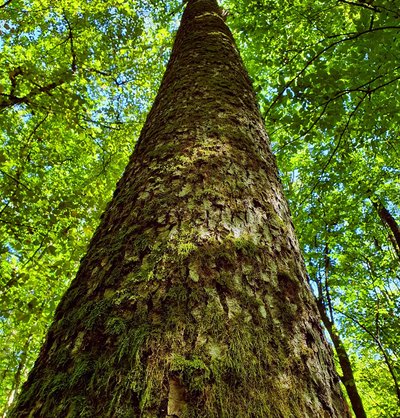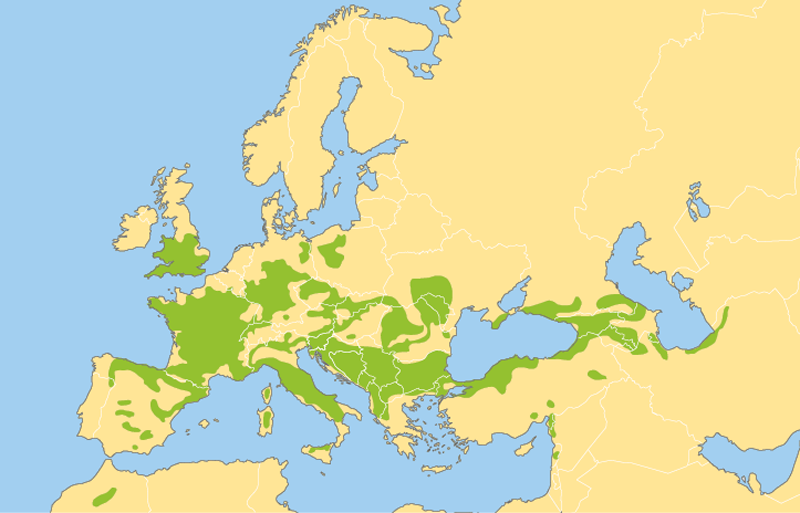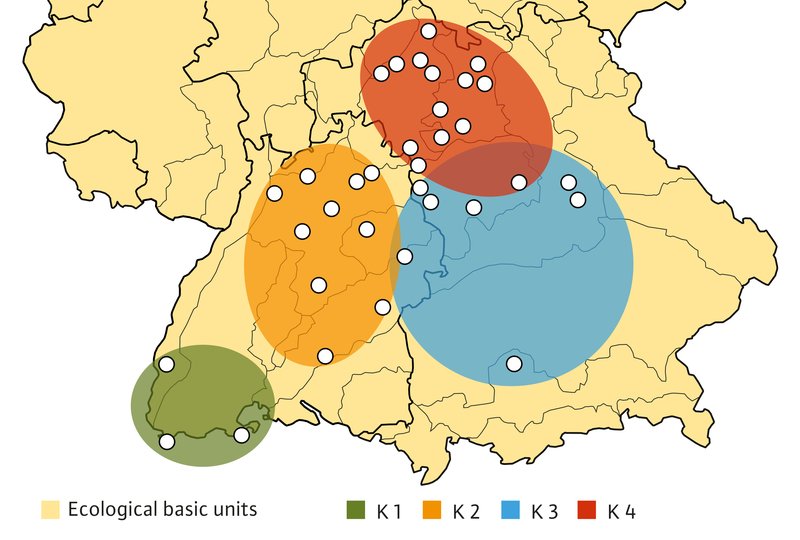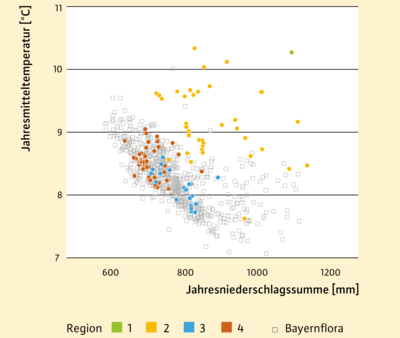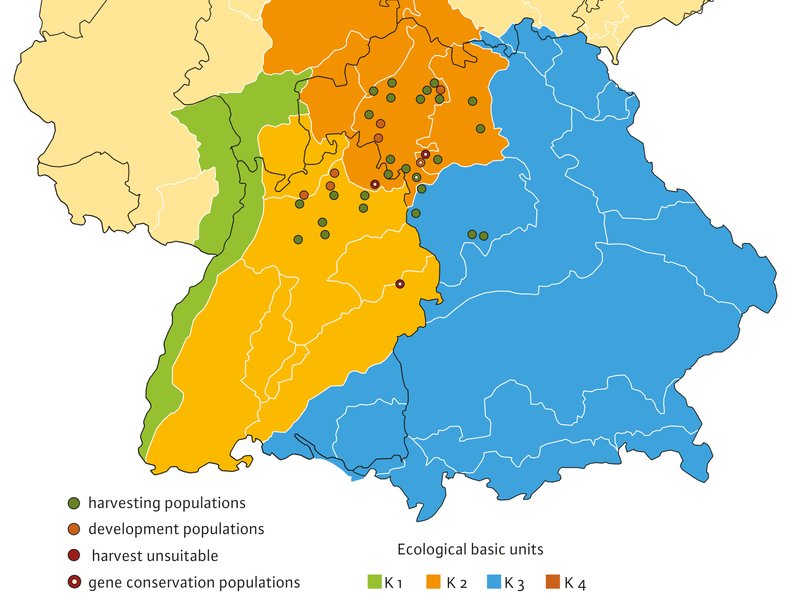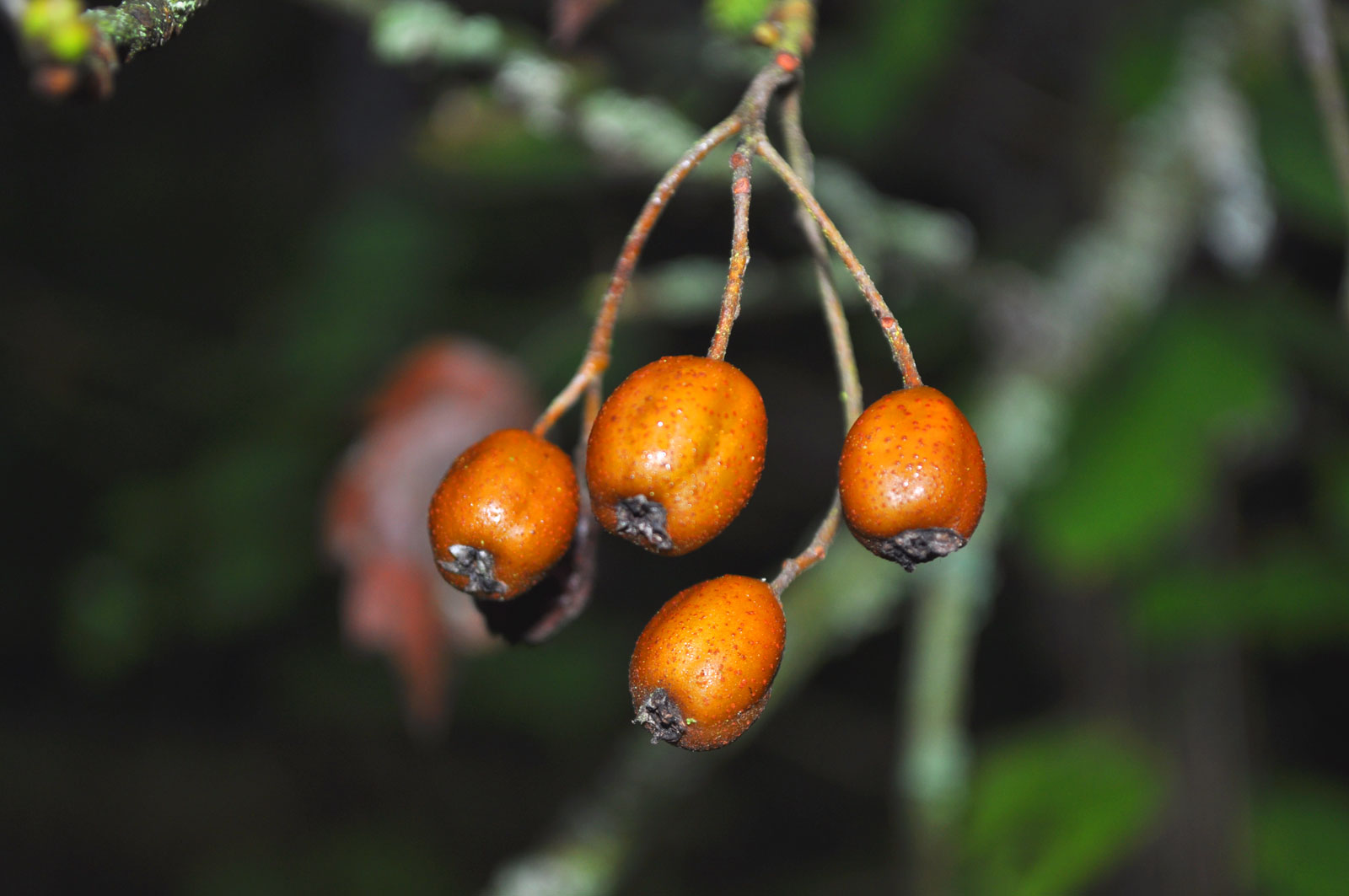The ever more tangible and visible consequences of climate change, such as heat, drought, storms and invasive damaging organisms, increasingly also pose a risk to the viability of our main native tree species. To broaden the spectrum of species and share the risk among several deciduous tree species, attention is increasingly also turning to rare native tree species. One tree species being considered as a possible alternative in climate change for warm-dry sites is the wild service tree, also known as the chequer tree. The Bavarian Office of Forest Genetics (“Amt für Waldgenetik”) has conducted intensive research into the forest genetics of the wild service tree and identified suitable sources of seed for this species.
Distribution
Sorbus torminalis, commonly known as the wild service or chequer tree, has a large natural distribution area (Fig. 2), stretching from southern Europe via Turkey to the Caspian Sea in Iran, and in the west from Spain and France to Great Britain. In central Europe the wild service tree is often to be found in small isolated populations. The environmental conditions in which it occurs are very diverse, ranging from cold and dry to warm and dry. Due to its low competitive ability in comparison with the beech, the wild service tree has up to now mainly held its ground against the beech and other tree species on extreme sites, at altitudes of up to 700 m above sea level. On good sites the wild service tree can reach heights of up to 32 m and diameters up to 100 cm.
Wild service tree project at the Bavarian Office for Forest Genetics (“AWG”)
Given the rising demand for planting material, greater attention should be paid to gathering high-quality seed, so that the silvicultural objectives of the forest owners can be achieved.
The wild service tree is not subject to the [German] law on forest reproductive material (“FoVG”). There are thus no legal restrictions on harvesting of its seed. Especially when it comes to forest conversion measures, special attention should however still be paid to the suitability and origins of the seed and planting material. The quality and population size of the seed-harvesting stands are important factors. Provenance trials should be conducted to establish which provenances are most suitable for the future cultivation of the wild service tree in Bavaria. The Bavarian Office for Forest Genetics has thus conducted research into the provenances of wild service trees and their genotypic and phenotypic characteristics, and set them against current climatic environmental conditions.
Research into provenance
One important concern in forestry is to investigate differences between trees of different provenances and genetic variations in their growth and quality features, as these have a key influence on the rotation period, and the trunk quality to be expected. Results from one study of provenances show that the Bavarian provenances “Sailershausen” and “Schweinfurt” perform best in the evaluation of the factors growth, trunk shape and forking formation. A further provenance in France also has above-average growth and quality characteristics. To evaluate the Bavarian populations better, the genotype and phenotype of the individual populations should also be investigated, as well as the respective environmental conditions. All characteristics (height and diameter growth, twisted growth, sprouting) of the forest populations are defined to differing extents by their genetics or the environmental conditions.
Genetics
In this study, 34 populations in southern Germany were assessed. On the basis of spatio-genetic structures, four different clusters were defined in Bavaria and Baden Württemberg (Fig. 3), which can be used to delimit the different provenances. In the course of this study, information is gathered simultaneously on the genetics of the harvesting and conservation stands. 23 populations - 15 in Bavaria and 8 in Baden Württemberg - fulfilled the genetic and phenotypic requirements for future harvesting in line with the intentions of the legislation on forest reproductive material (FoVG).
Environmental conditions
The environmental conditions in which wild service trees already occur may give some orientation as to what can be expected in Bavaria. The climatic conditions in the areas in which clusters of wild service trees currently occur are shown in Figure 4. It can be seen, for example, that most of the populations in Region 4 are already coping with a relatively low annual precipitation of approx. 700 mm and an average annual temperature of 8.5°C. It is also clear that individual populations can also hold their own at average annual temperatures of around 10°C if they have sufficient annual precipitation.
Designation of seed harvest stands and seed orchards
Using statistical analyses to delimit the regions on a genetic basis, Baier et al. (2017) propose four areas of provenance. These are loosely in line with the boundaries of the basic ecological units.
Figure 5 shows the spatial distribution of the harvesting, development and gene conservation stands in the proposed areas of provenance for the wild service tree in Bavaria and Baden-Württemberg. The supply situation in individual areas of provenance can ultimately be evaluated from this. In Bavaria there are two areas of provenance:
- 03 Mittelfränkisches Hügelland, Jura und Fränkische Alb, Alpen und Alpenvorland, Südostbayerisches Hügel- und Bergland (central Franconian hills, Jura and Franconian Alb, the Alps and Alpine foothills, south-east Bavarian hills and mountains)
- 04 Fränkisches Hügelland und Westdeutsches Bergland (Franconian hills and western German mountains)
In the appendix of the Bavarian harvesting approval register, there are currently four stands for Provenance 03 and 15 stands for Provenance 04; these are near Ansbach, Weissenburg, Uffenheim, Bamberg, Karlstadt, Bad Neustadt an der Saale, Kitzingen, Würzburg and Schweinfurt.
The Bavarian seed orchard “Neudorf” (BaySF Arnstein state forest company, Department for Food, Agriculture and Forestry in Schweinfurt), was founded in 1996 and is already being harvested. In 2016, 618 kg of seed were harvested. In 2019, on the other hand, just 59 kg of seed could be gathered. A comparison of the genetic diversity of the seed orchard and a group of 86 potential plus trees with the 34 natural populations reveals that both the seed orchard and the plus tree group have a higher rate of genetic diversity. Consequently, the harvesting possibilities and quality of the forestry reproductive material could be improved by establishing a new graft seed plantation on the plus trees.
Summary and outlook
The conservation and use of rare tree species are gaining considerably in importance in the light of rapidly changing environmental conditions. For one thing, ecologically valuable populations need to be preserved and the gene pool should not be corrupted by the introduction of unsuitable material. Secondly, these tree species should be promoted more from the economic point of view.
For both points, the genetic diversity of forest stands plays a decisive role, as this is the most important factor for the future adaptability and survival of tree species in the face of changing environmental conditions. Under the climate conditions to be expected, the wild service tree will become increasingly important. It will also be cultivated in areas where it has not occurred naturally before, such as the Tertiary Hills in the northern Alpine Foreland of southern Germany.
For this tree species to be cultivated successfully, suitable sources of seed must be identified. The populations from which seeds are gathered should stand out for their high level of genetic diversity, and the stands should be above average in appearance (structure, variety and diversity).
The natural populations of the wild service tree examined in the course of the wild service tree project and the plus trees gained from them can be recommended without reservation for seed harvesting. The designated development stands should continue to be managed with a view to designating them as harvesting stands later.
Certain French populations that also performed well in the provenance study can also be tested in practical cultivation trials. Because of the increasing demand for reproductive material from this ecologically and economically significant tree species, another seed orchard is currently being set up in Bavaria and Baden-Württemberg.

